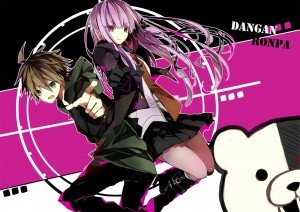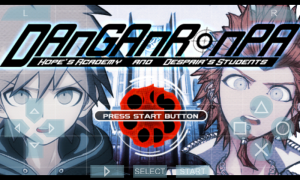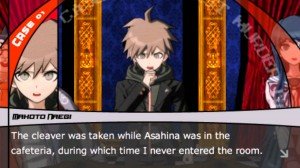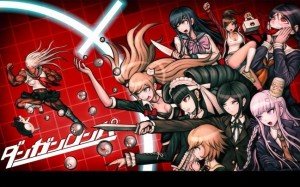This is a review of the exclusive Japanese (PSP) version of Danganronpa. The game is slated for a western release on the PS Vita under the title Danganronpa: Trigger Happy Havoc in February 2014. Danganronpa is brought to us by Japanese developer Spike and is described as a “High Speed Detective Action Game”, but it’s difficult to pin a specific genre tag to this game.
Danganronpa puts players in the shoes of high school student Makoto Naegi, an average student who by pot-luck has won the honor of attending Kibougamine Academy, a fantastic high school for incredibly gifted individuals. Naegi soon finds himself sealed within the academy along with 14 other high school students, who, unlike Naegi, are anything but average and are quite talented in one way or another.
The person responsible for keeping all the students trapped within the academy is none other than the headmaster, known as Monokuma, who appears as a small black-and-white teddy bear with a menacing red-eye. Monokuma explains to everyone that they are not only trapped within Kibougamine academy, but perpetually so, and the only way for them to leave is to “graduate”. However, in order for a student to graduate, they must murder a fellow student.
Over the course of the game, players will be able to explore Kibougamine Academy in a first-person view. Here, you’ll be able to examine objects and people in the environment in order to gain information. This is essentially the core gameplay mechanic for making progress.
While I feel that the core gameplay mechanics were implemented very well, players who are looking for a more action-oriented experience may find themselves growing bored of all the searching and character-focused moments. Those who don’t mind these slower-paced sections will be rewarded with some interesting, and often funny, side stories from some very likable and eccentric characters.
Between major events, players will be given “Free Time”. These segments give the player the option to search the many rooms found throughout the academy; in doing so, you’ll be able to discover hidden Monokuma coins that can be used in the school shop to win presents from the capsule machine. You’re also able to talk to, and hang out with, specific characters and give them presents, which in turn reveals more information about them and can unlock various Skills for use in the Class Trials.
As the story unfolds, Monokuma will provide what he calls “incentives”, as well as coming up with other methods to encourage the students to commit a murder. Once the inevitable first murder has occured, Monokuma will present everyone with an item called the Monokuma file, to aid in your investigation.
Thus begins the investigation phase, shifting the focus to that of a detective game. At a murder scene, you’ll be able to search the victim as well as the items and people in the area. Sadly, though, there really isn’t a lot of room for players to think outside of the box during the investigation phase, as everything worth searching is usually blatantly noticeable. While fun, it is very much just a matter of searching everything in the environment until you find something important.
Once the investigation phase is over, Monokuma will call for a class trial. These are by far the most action-packed and enjoyable portions of the game.
My favorite, and the most enjoyable part of a class trial, is the first event, called Non-Stop Discussion. This is a fast-paced debate where each student takes turns offering up either accusations, assumptions, contradictions, or misinformation, and by using the evidence gained during the investigation phase, the player can fire off ammunition in the form of written text that will break the weak point in a person’s argument.
While Non-Stop Discussion is fun and engaging, if you happen to misfire or choose the wrong ammunition, you’ll be required to listen to the discussion again and again until you get it right, which can become quite tedious.
My least favorite would have to be the second event, called Epiphany Anagram. Here you are given a word with missing letters; your task is to shoot the correct letters that appear floating on the screen in order to complete the word. It’s a rather simple mini-game that lacks any real challenge and is the weakest of the four trial events.
The third event is called Machine Gun Talk Battle, a one-on-one battle rhythm game. Here you’ll be required to press the correct buttons in time with the rhythm in order to wear down your opponent, and then fire off your final piece of evidence marking them as the real villain. While it is not as fun and engaging as the Non-Stop Discussion event, Machine Gun Talk Battle offers a small challenge that is far less tedious to replay if you happen to fail.
The fourth and final event is Climax Logic. By filling in the missing images with those provided, you’ll gradually piece together the events of the murder as it happened. Then you can sit back and watch the whole thing play out in manga-form. Although offering very little challenge when compared to previous events, Climax Logic does offer players a manga-esque reconstruction of how the murder actually played out.
Once you successfully complete all the trial phases, you’ll have pieced together exactly how the murder was committed, along with who committed it, resulting in the real villain receiving their “punishment” in the form of an over-the-top, tailor-made execution performed in a 3D mini-cutscene.
As a reward for successfully surviving a class trial, a new area will become available. This helps the game stay fresh and provides players with new places to investigate, as well as serving to advance the plot.
Danganronpa manages to stay fresh and interesting by introducing new rules, gameplay elements, places to search, and enough plot twists, character revelations, and anime pop culture references to keep the story interesting throughout. It’s truly a game that any anime fan would enjoy, and is certainly worth checking out when it hits Western shores in February 2014.
This review is based on a retail copy of the PSP version of Danganronpa developed by Spike.





